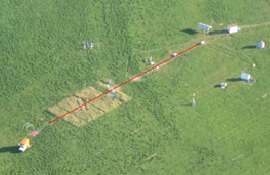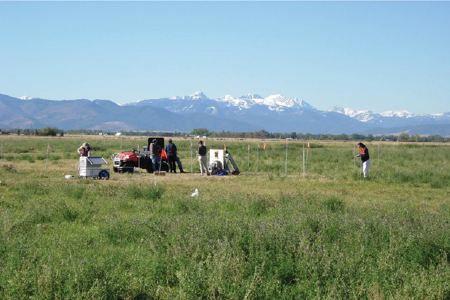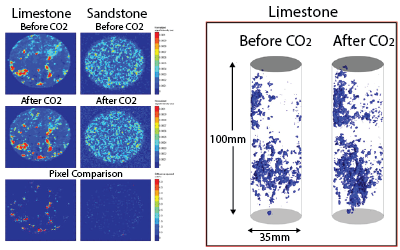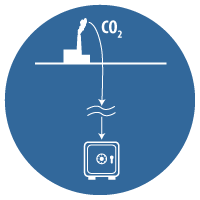The Zero Emission Research and Technology Collaborative (ZERT)

Aerial view of the ZERT field site. photo credit: K. Repasky
ZERT was a US Department of Energy funded project (award numbers DE-FC26-04NT42262, DE-FE0000397) focusing on basic science and technology development relevant to geologic carbon sequestration. The effort was directed by Lee Spangler at MSU. The collaborative involved five DOE national labs and two universities:
- Pacific Northwest National Laboratory (PNNL)
- National Energy Technology Laboratory (NETL)
- Los Alamos National Laboratory (LANL)
- Lawrence Berkeley National Laboratory (LBNL)
- Lawrence Livermore National Laboratory (LLNL)
- Montana State University (MSU)
- West Virginia University (WVU)
Multiple major multiphase flow simulators used to model underground injections were modified to handle CO2 specific properties. Codes modified include TOUGH (LBNL), FEHM (LANL), and STOMP (PNNL). Additionally, initial development of CO2 PENS, a LANL systems level tool for carbon sequestration occurred under ZERT.
ZERT also funded core scale CO2 - Brine - Rock experiments at multiple institutions (LBNL, MSU, PNNL) aimed at informing the code development efforts and at understanding reaction and reactive transport. Key studies at PNNL investigated the rapid mineralization reactions that occur in basalts for both dissolved and free phase CO2.

Zert field site
MSU and LBNL collaborated to build a first in the world field lab to study efficacy of near-surface detection technologies on MSU property. The ZERT field lab utilized a shallow (~1.5 m deep) 70 m horizontal well to run a controlled release of small amounts of CO2. Detection technologies tested included hyperspectral imaging, soil flux chambers, resistivity, tracers, eddy covariance, differential absorption light detection and ranging (LIDAR), and others. The first full operational year of this site resulted in a special issue of the Journal of Environmental Earth Sciences (March 2010) and data from the site has strongly influenced thinking regarding near surface detection strategies in the geologic carbon sequestration community. The ZERT field site was managed by Laura Dobeck and Lee Spangler and hosted over 100 investigators from six national labs, seven universities, and eight private sector companies.

Physical and Chemical Effects of Two-Phase Brine/Supercritical-CO2 Fluid Flow on Clastic Rocks: Real-Time Monitoring and NMR Imaging of Flow-Through Core Experiments
ZERT also seeded initial bench scale studies of Microbially Enhanced Coal Bed Methane (MECBM), investigating methods to stimulate indigenous microbes to convert more of the coal to methane. This MSU work has received subsequent DOE funding under other programs.
In its efforts to address potential caprock and wellbore integrity, ZERT initiated core-scale studies of biofilm and biomineral formation to plug small aperture, narrow channel leakage pathways. This work at MSU has progressed dramatically attracting multiple additional grants, industry interest, and successful down-well demonstration of this technology.
ZERT MSU investigators included Alfred Cunningham, Elliott Barnhart, David Lageson, Laura Dobeck, Kevin Repasky, Joseph A. Shaw, Sarah Codd, Matthew Fields, and Dave Bowen.
ZERT Publications
Modeling
Audigane, P., I. Gaus, I. Czernichowski-Lauriol, K. Pruess and T. Xu. Two-dimensional reactive transport modeling of CO2 injection in a saline aquifer at the Sleipner Site, North Sea. LBNL-61584. American Journal of Science, 307, 974—1008, DOI 10.2475/07.2007.02, September 2007.
Cortis, A., C.M. Oldenburg, and S.M. Benson, The role of optimality in characterizing CO2 seepage from geologic carbon sequestration sites, LBNL 1417E. Int. J. Greenhouse Gas Control, 2, 640-652, 2008.
Doughty, C., Investigation of CO2 plume behavior for a large-scale pilot test of geologic carbon storage in a saline formation, Transport in Porous Media, special issue on geologic carbon storage, doi:10.1007/S112423-009-9396-z, 2009.
Doughty, C. and Myer, L.R. Scoping calculations on leakage of CO2 in geologic storage, in Science and technology of carbon sequestration, B. McPherson and E. Sundquist, Editors, American Geophysical Union, Washington DC, in press, 2009.
Doughty, C., Estimating plume volume for geologic storage of CO2 in saline aquifers, LBNL 656E, Ground Water, 46, 6, 810-813, 2008.
Doughty, C., Modeling geologic storage of carbon dioxide: Comparison of hysteretic and non-hysteretic curves. LBNL-61176. Energy Conversion and Management, 48 (6), 1768—1871, 2007.
Doughty, C., L.R. Myer, and C.M. Oldenburg, Predictions of long-term behavior of a large volume pilot test for CO2 geological storage in a saline formation in the Central Valley, California, presented at Eighth National Conference on Carbon Capture and Sequestration, National Energy Technology Lab., Pittsburgh, PA, May 4-7, 2009.
Fang, Y., G.-T. Yeh, and W.D. Burgos, A General Paradigm to Model Reaction-Based Biogeochemical Processes in Batch Systems. Water Resources Research, 2003. 39(4): p. 1183-1107.
Gherardi, F., Xu, T., and Pruess, K. Numerical Modeling of Self-limiting and Self-enhancing Caprock Alteration Induced by CO2 Storage in a Depleted Gas Reservoir, Chem. Geol., in press.
Keating et al, Assessing our ability to predict impacts of a CO2 leak on shallow aquifer resources: reconciling model predictions with field observations at natural analog sites, 8th Annual CO2 Capture & Sequestration Conference, Pittsburgh, PA, May 4-7, 2009.
Melick, J.J. and Gardner M.H., 2009, Critical Geo-details in a Basin-scale Geologic Model for CO2Sequestration: Powder River Basin (PRB), NE Wyoming and SE Montana, Poster presentation , 8th Annual Conference on Carbon Capture & Sequestration, May 4th–7th, 2009, Pittsburgh, Pennsylvania. Status: presented.
Oldenburg, C.M., J.L. Lewicki, L. Pan, L. Dobeck, and L. Spangler, Origin of the Patchy Emission Pattern at the ZERT CO2 Release Test, Env. Earth Sci., submitted.
Oldenburg, C.M., J.L. Lewicki, L. Dobeck, and L. Spangler, Modeling Gas Transport in the Shallow Subsurface During the ZERT CO2 Release Test, Transport in Porous Media, LBNL-1529E, in press, available online, DOI 10.1007/s11242-009-9361-x.
Pruess, K. and N. Müller. Formation Dry-Out from CO2 Injection into Saline Aquifers: 1. Effects of Solids Precipitation and their Mitigation, Water Resour. Res.,Vol. 45, W03402, doi:10.1029/2008WR007101, 2009. (LBNL-1584E)
Pruess, K. Formation Dry-Out from CO2 Injection into Saline Aquifers: 2. Analytical Model for Salt Precipitation, Water Resour. Res., Vol. 45, W03403, doi:10.1029/2008WR007102, 2009. (LBNL-1584E-Pt2)
Pruess, K., J. Nordbotten and K. Zhang. Long-term Evolution of a CO2 Plume under a Sloping Caprock, submitted for presentation at the TOUGH Symposium 2009, Berkeley, CA, September 14-16, 2009.
Pruess K. and N. Spycher. ECO2N—A fluid property module for the TOUGH2 code for studies of CO2storage in saline aquifers, LBNL 61077. Energy Conversion and Management, 48, 1761-1767, doi:10.1016/j.enconman.2007.01.016, 2007.
Silin, D., and T.W. Patzek, and S. M. Benson. A one-dimensional model of vertical gas plume migration through a heterogeneous porous medium. International Journal on Greenhouse Gas Control, 2009, v. 3, 300-310.
Silin, D., T. Patzek, and S.M. Benson, A model of buoyancy-driven countercurrent two-phase fluid flow.LBNL-62607. Transport in Porous Media, in press, 2008.
Silin, D., Tad Patzek, and Sally Benson, A modeling of buoyant gas plume migration. Int. Journal of Greenhouse Gas Control, 2009, February, v. 76, No. 3, p. 449- 469.
Spycher, N. and K. Pruess, CO2-H2O Mixtures in the Geologic Sequestration of CO2. II. Partitioning in Chloride Brines at 12-100°C and up and up to 600 bar. Geochim Cosmochim. Acta, 2005. 69(13): p. 3309-3320.
Stauffer, P.H., H.S. Viswanathan, R.J. Pawar, and G.D. Guthrie, A System Model for Geologic Sequestration of CO2. Environmental Science & Technology Journal (accepted), 2008.
Steefel, C.I. and A.C. Lagasa, A Coupled Model for Transport of Multiple Chemical Species and Kinetic Precipitation/Dissolution Reactions with Applications to Reactive flow in Single Phase Hydrothermal System. American Journal of Science, 1994. 294: p. 529-592.
Todaka, N., S. Nakanishi, T. Xu, and K. Pruess, Hydrogeochemical modeling for natural analogue study of CO2 leakage due to Matsushiro Earthquake Swarm, Energy Procedia, Volume 1, p. 2413-2420, Elsevier, 2009. doi:10.1016/j.egypro.2009.02.002
Xiao, Y., T. Xu, and K. Pruess, The effects of gas-fluid-rock interactions on CO2 injection and storage: Insights from reactive transport modelling, Energy Procedia, Volume 1, p. 1783-1790, Elsevier, 2009. doi:10.1016/j.egypro.2009.01.233.
Xu, T., W. Zhang, and K. Pruess, Reaction-driven aqueous density increase and convective mixing during long-term CO2 storage in a saline sandstone formation, Transport in Porous Media (special issues on CO2 geological sequestration), Re-submitted after revision, 2009.
Xu, T., J. A. Apps, K. Pruess, and H. Yamamoto, Numerical modeling of injection and mineral trapping of CO2 with H2S and SO2 in a sandstone formation, Chemical Geology, v. 242/3-4, p. 319-346, 2007.
Xu, T., J.A. Apps, and K. Pruess, Numerical Simulation of CO2 Disposal by mineral Trapping in Deep Aquifers. Applied Geochemistry, 2004. 19: p. 917-936.
Zhang, K., C. Doughty, Y.S. Wu and K. Pruess. Efficient parallel simulation of CO2 geologic sequestration in saline aquifers, paper SPE-106026, submitted to SPE Journal, December 2006.
Monitoring
Amonette, J. E., and J. L. Barr. 2009. Multi-Channel Auto-Dilution System for Remote Continuous Monitoring of High Soil-CO2 Fluxes . PNNL-18229, Pacific Northwest National Laboratory, Richland, Washington.
Barr, J.L., S.D. Humphries, A.R. Nehrir, K.S. Repasky, L. Dobeck, J.L. Carlsten, and L. Spangler, Laser Based Carbon Dioxide Monitoring Instrument Testing During a Thirty Day Controlled Underground Carbon Release Field Experiment. Submitted to International Journal of Greenhouse Gas Control.
Humphries, S.D., A.R. Nehrir, C.J. Keith, K.S. Repasky, L. Dobeck, L. Carlsten, and L. Spangler, Testing Carbon Sequestration Site Monitoring Instruments Using a Controlled Carbon Dioxide Release Facility.Applied Optics, 2008. 47: p. 548-555.
Keith, Charlie J., Kevin S. Repasky, Rick L. Lawrence, Steven C. Jay, and John L. Carlsten. Monitoring Effects of a Controlled Subsurface Carbon Dioxide Release on Vegetation Using a Hyperspectral Imager. Accepted for publication in the International Journal of Greenhouse Gas Control, 2009.
Lewicki, J. L. and G.E. Hilley, Eddy covariance mapping and quantification of surface CO2 leakage fluxes, LBNL-2633E, Geophysical Research Letters, in press, September 2009.
Lewicki, J. L., G.E. Hilley, M.L. Fischer, L. Pan, C.M. Oldenburg, L. Dobeck, and L. Spangler, Eddy covariance observations of surface leakage during shallow subsurface CO2 releases, Journal of Geophysical Research - Atmospheres, 114, D12302, doi:10.1029/2008JD011297, 2009.
Lewicki, J.L., C.M. Oldenburg, L. Dobeck, and L. Spangler, Surface CO2 leakage during two shallow subsurface CO2 releases, Geophysical Research Letters, 34, L24402, doi:101029/2007GL032047, 2007.
Repasky, K.S., S.D. Humphries, and J.L. Carlsten, Differential Absorption Measurements of Carbon Dioxide Using a Temperature Tunable Distributed Feedback Diode Laser. Review of Scientific Instruments, 2006. 77.
Biofilms
Cunningham, A.B., R. Gerlach, L. Spangler, L. Schultz and A.C. Mitchell. Microbially Enhanced Geologic Containment of Sequestered Supercritical CO2. Proceedings, 9th International Conference on Greenhouse Gas Technologies,16-20 November, 2008.
Ebigbo, A., R. Helmig, A.B. Cunningham, H. Class, and R. Gerlach.(submitted). Modeling biofilm growth in the presence of carbon dioxide and water flow in the subsurface. Submitted to Advances in Water Resources, October 2009.
Gerlach, R., A.B. Cunningham, (In Review). Influence of Biofilms on Porous Media Hydrodynamics. Vafai, K. (ed.), Porous Media: Applications in Biological Systems and Biotechnology. Taylor Francis. To appear in 2010.
Gerlach, R., A.C. Mitchell, L. Schultz, and A.B. Cunningham. Metal and carbon dioxide sequestration through biologically induced mineral precipitation: Influence of hydrodynamics. ACS 237th National Meeting Division of Geochemistry, Salt Lake City, March 22, 2009.
Gerlach, R., A.C. Mitchell, L. Schultz, and A.B. Cunningham. Biofilm mediated calcite precipitation: controlling hydraulic conductivity, carbon sequestration, and the transport of radionuclides. Center for Biofilm Engineering Technical Advisory Conference, Montana State University, February 3-4, 2009.
Mitchell A.C., K. Dideriksen, L.H. Spangler, A. B. Cunningham, R. Gerlach. (submitted). Microbially enhanced carbon capture and storage by mineral-trapping and solubility-trapping. Submitted to Environmental Science and Technology, October 2009.
Mitchell, A., Phillips, M. Hamilton, R. Gerlach, J. Kuszuba, and A.B. Cunningham, Resilience of Planktonic and Biofilm Communities to Supercritical CO2. The Journal of Supercritical Fluids, 2008. 47(2): p. 318-325.
Mitchell, A.C., A. Phillips, J. Kaszuba, W.K. Hollis, R. Gerlach, and A.B. Cunningham, A Microbially Enhanced Carbonate Mineralization and Containment of CO2. Geochemica et Cosmochimica Acta, 2008. 72(12).
Mitchell, A.C., R. Phillips, R. Hiebert, R. Gerlach, and A.B. Cunningham, Biofilm Enhanced Subsurface Sequestration of Supercritical CO2. International Journal of Greenhouse Gas Control, 2009. 3(1).
Schultz, L.N., B. Pitts, A. C. Mitchell, A.B. Cunningham, R. Gerlach (Submitted) Imaging Biologically-Induced Mineralization in Fully Hydrated Flow Systems. Submitted to Microscopy Today, October 2009.
Schultz, L., B. Pitts, R. Gerlach, (2009): Imaging biomineralization in flow systems. Platform Presentation. Microscopy and Microanalysis Conference, Richmond, VA, July 25-31, 2009.
Schultz L., A.B. Cunningham and R. Gerlach. Image and Tracer Analysis of Biofilm and Mineral Affected Porous Media. Platform presentation, Biofilm Science and Technology Meeting, Center for Biofilm Engineering, Montana State University, July 8-9, 2009.
Seymour, J.D., E. O. Fridjonsson, L.N. Schultz, R. Gerlach, A.B. Cunningham, S.L. Codd.( Submitted). NMR Measurements of Hydrodynamic Dispersion in Porous Media Subject to Biofilm Mediated Precipitation Reactions. Submitted to Journal Of Contaminant Hydrology December 2009.
Basic Science
Birkholzer J, G Bromhal, CF Brown, S Carroll, H Edenborn, J Fessenden, G Guthrie, A Hakala, E Keating, N Spycher, B Strazisar, and A Thompson. 2009. National Risk Assessment Program: Potential Effects on Groundwater Resources. Presented at Eighth Annual Conference on Carbon Capture and Sequestration, Pittsburgh, Pennsylvania, May4-7, 2009.
Hakala et al, Effect of CO2 on groundwater geochemistry in unconsolidated sand and gravel aquifers: experimental results from a natural analog site, 8th Annual CO2 Capture & Sequestration Conference, Pittsburgh, PA, May 4-7, 2009.
Hansen, L. (2009) Design and Experimental Testing of a High Pressure, High Temperature Flow-Through Rock Core Reactor Using Supercritical Carbon Dioxide. MSc. thesis, Department of Earth Sciences, Montana State University. 70pp.
Ito, T., T. Xu, M. Sakurai, K. Sekine, A concept of in-situ reaction method to remedy leakage from geological CO2 storage reservoirs, Int. J. Greenhouse Gas Control, submitted, 2008.
Jordan, P. and C. Doughty, Considerations for scale-up between the Kimberlina Phase III Pilot and full deployment, presented at Eighth National Conference on Carbon Capture and Sequestration, National Energy Technology Lab., Pittsburgh, PA, May 4-7, 2009.
Lewicki, J.L., M.L. Fischer, and G.E. Hilley, Six-week time series of eddy covariance CO2 flux at Mammoth Mountain, California: performance evaluation and role of meteorological forcing, LBNL 181E. Journal of Volcanology and Geothermal Research, 171, 178-190, 2008.
Lewicki, J.L., G.E. Hilley, T. Tosha, R. Aoyagi, H. Yamamoto, and S.M. Benson, Dynamic coupling of volcanic CO2 flow and wind at the Horseshoe Lake tree kill, Mammoth Mountain, CA. LBNL-62375. Geophysical Research Letters, 34, L03401, doi:10.1029/2006GL028848, 2007.
Oldenburg, C.M., Joule-Thomson, Cooling due to CO2 injection into natural gas reservoirs, LBNL-60158. Energy Conversion and Management, 48, 1808-1815, 2007.
Repasky, K.S., A.R. Nehrir, J.T. Hawthorne, G.W. Switzer, and J.L. Carlsten, Extending the Continuous Tuning Range of an External Cavity Diode Laser. Applied Optics, 2006. 45: p. 9013-9020.
Tomutsa, L., D. Silin, S.M. Benson, and T. Patzek, Synchrotron Microtomography CO2 Geosequestration Research. EOS Transactions, 2005. 82(52).
Viswanathan et al, The evolution of damage zones due to geo-mechanical and chemical effects caused by CO2 injection, 8th Annual CO2 Capture & Sequestration Conference, Pittsburgh, PA, May 4-7, 2009.
Wei, Z., Y. Li, T. Xu, H. Cheng, Y. Zheng, and P. Xiong, Long-term Variations of CO2 trapped in Different Mechanisms in Deep Saline Formations: A case study of the Songliao Basin, China. Greenhouse Gas Control Technologies 2008.
Wilson, T., Bajura, R., Winschel, R., Srivastava, R., Scandrol, R., Wells, A., and Patchen, D., 2009, Geophysical Characterization of the Marshall County West Virginia Pilot Sequestration Site: proceedings of the 26th Annual International Pittsburgh Coal Conference, Sept. 20 -23, 11 pages, available on Proceedings CD.
Xu, T., and K. Pruess, Enhanced solubility trapping, convection mixing, and mineral trapping for long-term CO2 storage in a saline sandstone formation, Transport in Porous Media, submitted, 2008.
Zhang, W., Y. Li, T. Xu, H. Cheng, Y. Zheng, and P. Xiong, Long-term variations of CO2 trapped in different mechanisms in deep saline formations: A case study of the Songliao Basin, China. LBNL-924E. Int. Journal of Greenhouse Gas Control, v3(2), p. 161-180, 2009.



